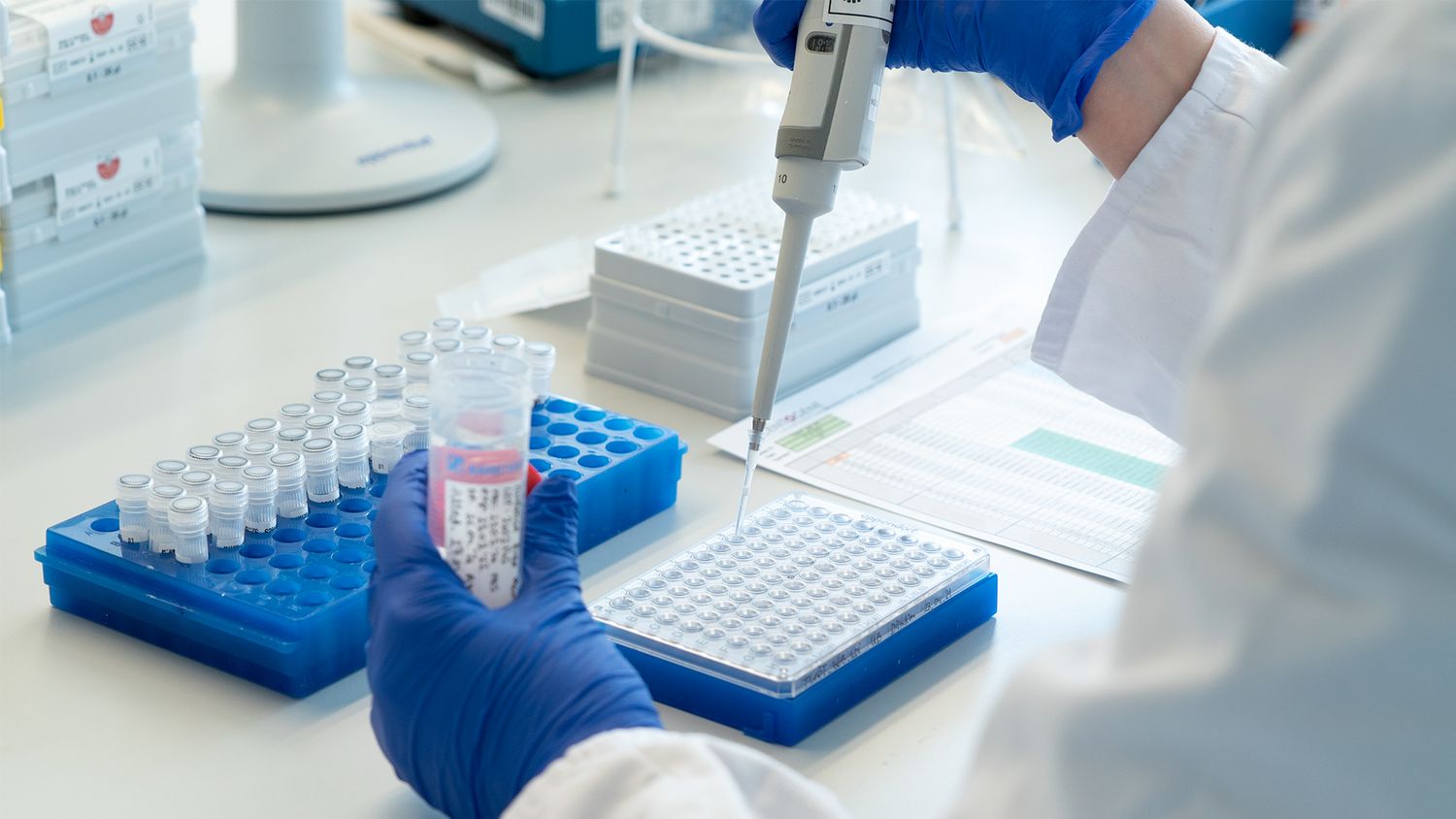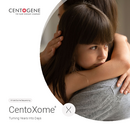Whole Exome Sequencing
CentoXome® – Turning Years Into Days
It takes approx. 7 years to diagnose a patient with a rare disease. With CentoXome, we can turn those years into days – powered by our best-in-class insights based on superior technology, our extensive clinical experience, and wealth of genetic data in rare and neurodegenerative diseases.
Our Enhanced Whole Exome Sequencing Service
Whole Exome Sequencing (WES) is a comprehensive genetic test that identifies changes in a patient's DNA that are causative or related to their medical concerns. By focusing on the entire protein-coding regions of the genome – the exome – WES offers you the coverage you need to diagnose patients rapidly and reliably.
Overcoming the Obstacles of Rare and Neurodegenerative Disease Diagnostics with CentoXome
With more than 7,000 identified rare diseases and approximately 80% being linked to genetic causes, diagnosing rare disease patients can often be difficult – resulting in lengthy, expensive, and emotional diagnostic odysseys.1,2
With WES, this doesn’t have to be the case. Containing the majority (~85%) of known disease-causing changes, WES uncovers the cause of rare diseases in less time and at a lower overall cost – leading to better patient outcomes. With CentoXome, we’ve taken WES to the next level. Enhanced to provide unparalleled clinical coverage and diagnostic power in a single test, our product design and medical interpretation utilize the world’s largest real-world data repository for rare and neurodegenerative diseases – the CENTOGENE Biodatabank.
Your advantage: Diagnosing complex and unsolved patient cases – quicker and with the highest levels of certainty.
Why Choose CentoXome?
Turn Your Open Questions Into Answers
Superior technology from experts in multiomic testing for rare and neurodegenerative diseases combined with outstanding clinical coverage and unmatched diagnostic power in a single test
Turn Our Expertise Into Your Advantage
Best-in-class insights powered by CENTOGENE’s CE-IVD Bioinformatics pipeline and the CENTOGENE Biodatabank
Turn Our Commitment Into Your Promise
Life-long support by a team dedicated to improving the lives of patients with rare diseases
Outstanding Clinical Coverage and Diagnostic Power
The CentoXome design and service delivers ideal quality and performance from the world leader and trusted partner in rare and neurodegenerative disease diagnostics with outstanding clinical coverage and unmatched clinical diagnostic power in a single test. Coupling insights from the CENTOGENE Biodatabank for rare and neurodegenerative diseases with superior omics technology, you benefit from a solution that delivers a higher diagnostic yield compared to standard WES.3–12
Key Features & Performance | |||||
|---|---|---|---|---|---|
| Broad and Uniform Exome & Mitochondrial Genome Coverage |
| ||||
| Enhanced coverage of Clinically Relevant Regions |
| ||||
| Advanced and Sensitive Variant Detection |
| ||||
SNVs: single nucleotide variants; InDels: small insertions/deletions; CNVs: copy number variations; UPD: uniparental disomy; mtDNA: mitochondrial DNA.
* CNV detection software sensitivity > 95 %; however, this sensitivity may be decreased for repetitive and homologous regions, such as pseudogenes, as well as for events spanning two or fewer exons.
** Variants with low quality and/or unclear zygosity are confirmed by orthogonal methods: SNVs and InDels by Sanger sequencing; CNVs by Multiplex ligation-dependent probe amplification (MPLA), quantitative polymerase chain reaction (qPCR) or chromosomal microarray (CMA).
*** Screening of UPD is performed using an in-house algorithm for Mendelian Inheritance Errors (MIE) to detect runs of homozygosity (ROH) for the well-known clinically relevant chromosomal regions. Guaranteed internal confirmatory testing using CMA when necessary.

When Is WES Recommended?
CentoXome offers a rapid and cost-effective solution for diagnosing rare and neurodegenerative diseases, serving as both a first-line and second-line test to identify molecular diagnoses in patients with suspected genetic disorders or negative results from prior genetic testing.3, 5, 11 Moreover, it may provide a cost-effective alternative to multiple independent molecular assays, thereby streamlining the diagnostic process.
WES has traditionally been recommended when patients present with complex, heterogeneous phenotypes suggestive of multiple conditions or when prior genetic testing has been inconclusive. Its utilization in clinical practice has significantly increased in recent years, surpassing standard genetic tests such as single genes, NGS panels, and chromosomal microarray analysis.4, 10, 13–15 Additionally, there is growing evidence of the economic value of using WGS/WES as a first-line test.16–18 Guidelines from the ACMG (American College of Medical Genetics and Genomics) and other medical societies recommend exome/genome sequencing as a first- or second-line diagnostic test when a patient’s symptoms or family history suggest a genetic cause of the diseases.19–22 Furthermore, test results from WES may lead to more rapid diagnoses, improved prevention of symptomatic illness, more targeted treatments, or even eliminate the need for some costly or invasive procedures.10 ,14, 15, 19, 23
We particularly recommend CentoXome for patients when:
- Symptoms are very broad, complex, or unspecific, not pointing towards specific disease or typical phenotype
e.g., patients with developmental delay, intellectual disability, autism spectrum disorder, epilepsy - Suspicion of chromosomal imbalances, microdeletion, or microduplication syndromes
e.g., children with global development delay, and/or multiple congenital anomalies, DiGeorge syndrome - Clinical suspicion of mitochondrial disease
e.g., patients with muscular weakness, cardiomyopathy, visual problems - A severe presentation in the neonatal or childhood period
e.g., neonate babies and infants critically ill in Neonatal and Pediatric Intensive Care Units (NICU and PICU, respectively) - Prior genetic testing did not provide a conclusive diagnosis
e.g., patient with neurodevelopmental delay, with similarly affected siblings, and negative testing with microarrays - Need a cost-conscious alternative to Whole Genome Sequencing (WGS)
CentoXome can help you tackle challenging and undiagnosed patient cases across all stages of life and covers a broad spectrum of disorders encompassing >7,000 rare diseases
Relevant Case Studies
Identifying an Intronic Positive Variant With CentoXome
Identifying a Clinically Relevant Mitochondrial Variant with CentoXome
Unraveling a Clinically Relevant Uniparental Disomy With CentoXome
Tailored Testing and Life-Long Diagnostic Support
We offer flexible testing options and additional services to provide a CentoXome analysis tailored to your patient’s needs, such as, for example, WES for ongoing pregnancies with fetal abnormalities for prenatal diagnostics (CentoXome Prenatal), and our multiomic WES solutions (CentoXome MOx 1.0 and 2.0) integrate different data sets, serving as highly effective tools for the early diagnosis of rare and neurodegenerative diseases.
Committed to improving the lives of patients with rare and neurodegenerative diseases, CentoXome is paired with life-long diagnostic support via a free-of-charge and proactive reclassification program, as well as an affordable case-level reanalysis in case of uncertain or negative results. WES diagnostic yield is continuously increasing due to the rapid rate of new gene-disease discoveries, and it is estimated that about 10–20% of undiagnosed patients can be diagnosed by reclassification and genomic data reanalysis.15, 24
Options & Additional Services | |||
|---|---|---|---|
| Testing Design* |
| ||
Testing Solutions | CentoXome |
| |
| CentoXome MOx** |
| ||
| CentoXome Prenatal*** |
| ||
| CentoXome POC*** |
| ||
| CentoXome Variants |
| ||
| Additional Options | FAST Processing |
| |
| Free of Charge Raw Data |
| ||
| Life-long diagnostic support**** |
| ||
TAT: Turnaround time
* Solo: only affected index patient is tested; Duo: index patient and affected or unaffected family member are tested; Trio: index patient and two family members, affected or unaffected are tested; PLUS: additional family member beyond Trio is tested.
** More details about our Multiomic Solutions.
*** WES-based mitochondrial genome analysis and screening for UPD is not offered due to technical limitations. More details about Prenatal Testing.
**** Case reanalysis is available only for orders with original sequencing data from August 2020 onwards. More details about Variant Reclassification Program.

Best-in-Class Insights by the Leader & Trusted Partner in Rare and Neurodegenerative Disease Diagnostics
When choosing our WES, physicians, patients, and partners can feel confident that they will receive high-quality sequencing combined with best data analysis and interpretation, documented in comprehensive medical reports. By combining deep phenotype data with genotype data using our CE-IVD bioinformatics pipeline, CENTOGENE accurately identifies disease-causing variants to deliver best-in-class clinical reporting.
CentoXome always includes medical reporting based on our clinical interpretation expertise, best-in-class curated variant data from our Biodatabank, and international best-practice guidelines. A team of highly trained clinical geneticists and scientists interpret the data and cross-check every medical report. All historical high-quality classifications are curated and codified in our Biodatabank, which is a reference for diagnostic decisions and classifications.
Test reports always contain clear actionable clinical results, recommendations, and follow-up options. They are phenotype-driven and focused on reporting findings related to the patient’s clinical presentation/patient’s indications.

Additional Information & Resources

CentoXome – Product Sheet
CentoXome – Whole Exome Sequencing

CentoXome – Patient Information
CentoXome® – Whole Exome Sequencing (WES)
Transforming the Way You Analyze Genetic Data: An Inside Look at CentoCloud's New Innovation
Watch our on-demand webinar to enable rapid bioinformatic analysis and interpretation of Next Generation Sequencing (NGS) data.
CentoCloud – Discover a New World of Medical Diagnostics
Join us on November 2 as we open the digital doors to a new world of medical diagnostics. Throughout the webinar, our speakers, Ana Popic, Head of CENTOGENE Belgrade, and Martin Shumanov, Regional […]
Rewrite the Future of Rare Diseases With Multiomics
Our speakers, Maximilian Schmid M.D., Chief Commercial Officer – Diagnostics, and Prof. Peter Bauer M.D., Chief Genomic Officer, will highlight the power of multiomics in establishing a complete […]
A Dx Success Story Showing the Clinical Utility of Genomic Testing as a First-Line Diagnostic Test
Genetic disorders are prevalent in many developing countries, but access to genomic testing is limited. In the frame of a charity testing program, CENTOGENE has provided diagnoses for more than 200 […]
Clinical Exome Sequencing – Results from 2819 Samples Reflecting 1000 Families
A study was conducted using whole exome sequencing (WES) to identify underlying pathogenic variants, or likely pathogenic variants, in 1,000 diagnostic cases from 54 different countries. Patients […]
Leveraging the CENTOGENE Biodatabank and Genomic Testing to Discovers Six New Rare Diseases
While technology has advanced over the past ten years, more than half of patients with genetic diseases remain undiagnosed, even after applying genome-wide diagnostic approaches. By performing deep […]
Get in Touch With Our Customer Support
Our consultation service is available in several languages.
+49 (0) 381 80 113 - 416
Mon. – Fri. 7 a.m. – 6:30 p.m. CET
Sat. 8 a.m. – 12 p.m. CET
References
1RARE Facts – Global Genes; 2NIH Genetics and Rare Disease (GARD); 3Cheema et al. 2020, PMID: 33083013; 4Clark et al. 2018, PMID: 30002876; 5Data on file at CENTOGENE; 6Gross et al. 2018, PMID: 30293986; 7Posey et al. 2019, PMID: 31234920; 8Schon et al. 2020, PMID: 32674947; 9Scuffins et al. 2021, PMID: 33495530;10Stark et al. 2016, PMID: 26938784;11Trujillano et al. 2017, PMID: 27848944;12Wagner et al. 2019, PMID: 31059585; 13Srivastava et al. 2019, PMID: 31182824; 14 Smith. et al.2019, PMID: 29760485; 15 Vissers et al. 2017, PMID: 28333917; 16 Bowling et al. 2017, PMID: 28554332; 17 Malinowski et al. 2020, PMID: 32203227; 18 Trosman et al. 2020, PMID: 31501586); 19 Manickham et al. 2021, PMID: 34211152; 20 Matthijs et al. 2016, PMID: 2762856; 21 Souche et al. 2022, PMID: 35577938; 22 Boycott et al. 2015, PMID: 25951830); 23 Liu et al. 2019, PMID: 31216405; 24 Wright et al. 2018, PMID: 29323667; 25Clinical Genome Resource. www.clinicalgenome.org; 26 Miller et al. 2021, PMID: 34012069; 27 Richards et al. 2015, PMID: 25741868.

